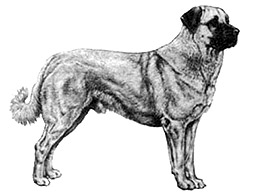Anatolian Shepherd Dog Breed Standard
Last updated: 15 Nov 2018
A breed standard is the guideline which describes the ideal characteristics, temperament, and appearance of a breed and ensures that the breed is fit for function with soundness essential. Breeders and judges should at all times be mindful of features which could be detrimental in any way to the health, welfare or soundness of this breed.

Kennel Club dated September 2016
-
Group:
Group 6 (Utility)
-
History:
-
General Appearance:
Large upstanding, tall, powerfully built, with broad, heavy head and short dense coat. Must have size, stamina and speed.
-
Characteristics:
Active breed used originally as a guard dog for sheep; hard working; capable of enduring extremes of heat and cold.
-
Temperament:
Steady and bold without aggression, naturally independent, very intelligent. Proud and confident.
-
Head And Skull:
Skull large, broad and flat between ears. Slight furrow between eyes and slight stop. Mature males have broader head than females. Foreface one third of total head length. Slightly pendulous black lips. Square profile. Nose black.
-
Eyes:
Relatively small in proportion to size of skull, set well apart and deep, showing no haw. Golden to brown in colour. Eye rims black.
-
Ears:
Medium sized, triangular in shape, rounded at tip, carried flat to skull and pendant, higher when alert.
-
Mouth:
Teeth strong, with a perfect, regular and complete scissor bite, i.e. upper teeth closely overlapping lower teeth and set square to the jaws. Lips black.
-
Neck:
Slightly arched, powerful, muscular, moderate in length, rather thick. Slight dewlap.
-
Forequarters:
Shoulders well muscled and sloping. Forelegs set well apart, straight and well boned; of good length; strong pasterns, slightly sloping when viewed from side. Elbows close to sides.
-
Body:
Chest deep to point of elbow, ribs well sprung. Body powerful, well muscled, never fat. Level back. Body in proportion to leg length, slightly arched over loins, with good tuck-up.
-
Hindquarters:
Powerful, lighter than forequarters; moderate turn of stifle.
-
Feet:
Strong feet with well-arched toes. Nails short.
-
Tail:
Long, reaching at least to hock. Set on rather high. When relaxed carried low with slight curl, when alert carried high with end curled over back, especially by males.
-
Gait/Movement:
Relaxed even gait, with impression of latent power, very supple movement. Noticeable straight line of head, neck and body, giving impression of stalking in some dogs. Great drive when viewed from side.
-
Coat:
Short, dense with thick undercoat. Flat, close-lying, neither fluffy nor wavy. Slightly longer and thicker at neck, shoulders and tail; no feathering on ears or legs.
-
Colour:
All colours except merle are acceptable, with or without black mask and black ears.
-
Sizes:
Height: dogs: 74-81 cms (29-32 ins) at the shoulders; bitches: 71-79 cms (28-31 ins). Weight: mature dogs: 50-64 kgs (110-141 lbs); bitches: 41-59 kgs (90-130 lbs).
-
Faults:
Any departure from the foregoing points should be considered a fault and the seriousness with which the fault should be regarded should be in exact proportion to its degree and its effect upon the health and welfare of the dog and on the dog’s ability to perform its traditional work.
-
Notes:
Male animals should have two apparently normal testicles fully descended into the scrotum.
 For owners
For owners
 Members
Members
 Dogs Australia is a not-for-profit organisation advocating for the preservation of purebred dogs through ethical breeding.
It champions the highest standard of animal welfare through education and fostering dog-loving communities.
Internationally recognised and established in 1958 as the Australian National Kennel Council (ANKC),
the organisation promotes responsible dog ownership; maintains the ORCHID* heritable canine diseases database;
funds research into canine diseases; and supports state and territory-based member bodies.
Dogs Australia promotes breed conformation shows and community sports for dogs that fulfil a breed’s natural instincts.
Dogs Australia is a not-for-profit organisation advocating for the preservation of purebred dogs through ethical breeding.
It champions the highest standard of animal welfare through education and fostering dog-loving communities.
Internationally recognised and established in 1958 as the Australian National Kennel Council (ANKC),
the organisation promotes responsible dog ownership; maintains the ORCHID* heritable canine diseases database;
funds research into canine diseases; and supports state and territory-based member bodies.
Dogs Australia promotes breed conformation shows and community sports for dogs that fulfil a breed’s natural instincts.







